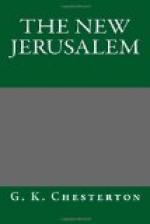In the midst of emotions that have moved the whole world out of its course, girt about with crowds who will die or do murder for a definition, the educated English gentleman in his blindness bows down to wood and stone. For the only thing wrong about that admirable man is that he is blind about himself.
No man will really attempt to describe his feelings, when he first stood at the gateway of the grave of Christ. The only record relevant here is that I did not feel the reaction, not to say repulsion, that many seem to have felt about its formal surroundings.
Either I was particularly fortunate or others are particularly fastidious. The guide who showed me the Sepulchre was not particularly noisy or profane or palpably mercenary; he was rather more than less sympathetic than the same sort of man who might have shown me Westminster Abbey or Stratford-on-Avon. He was a small, solemn, owlish old man, a Roman Catholic in religion; but so far from deserving the charge of not knowing the Bible, he deserved rather a gentle remonstrance against his assumption that nobody else knew it. If there was anything to smile at, in associations so sacred, it was the elaborate simplicity with which he told the first facts of the Gospel story, as if he were evangelising a savage. Anyhow, he did not talk like a cheap-jack at a stall; but rather like a teacher in an infant school. He made it very clear that Jesus Christ was crucified in case any one should suppose he was beheaded; and often stopped in his narrative to repeat that the hero of these events was Jesus Christ, lest we should fancy it was Nebuchadnezzar or the Duke of Wellington. I do not in the least mind being amused at this; but I have no reason whatever for doubting that he may have been a better man than I. I gave him what I should have given a similar guide in my own country; I parted from him as politely as from one of my own countrymen. I also, of course, gave money, as is the custom, to the various monastic custodians of the shrines; but I see nothing surprising about that. I am not quite so ignorant as not to know that without the monastic brotherhoods, supported by such charity, there would not by this time be anything to see in Jerusalem at all. There was only one class of men whose consistent concern was to watch these things, from the age of heathens and heresies to the age of Turks and tourists; and I am certainly not going to sneer at them for doing no practical work, and then refuse to pay them for the practical work they do. For the rest, even the architectural defacement is overstated, the church was burned down and rebuilt in a bad and modern period; but the older parts, especially the Crusaders’ porch, are as grand as the men who made them. The incongruities there are, are those of local colour. In connection, by the way, with what I said about beasts of burden, I mounted a series of steep staircases to the roof of the convent beside the Holy Sepulchre. When I got to the top I found myself in the placid presence of two camels. It would be curious to meet two cows on the roof of a village church. Nevertheless it is the only moral of the chapter interpolated here, that we can meet things quite as curious in our own country.




